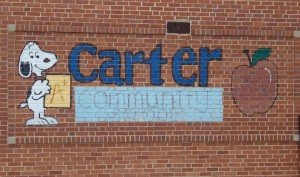Grade-Schoolers Learn Money 101
Sharon McCloskey | Jun 04, 2009 | Comments 59

By SHARON McCLOSKEY
DURHAM, N.C. - It’s Wednesday afternoon, and the usual collection of suits has gathered to discuss the past week’s revenues and assess the progress of their financial plan.
Board room? Rotary club? Stock exchange?
Not exactly.
This is the Carter Community School in Durham, N.C., and it’s grade-schoolers wearing those suits and dresses. And in this time of collective national anxiety over the state of our finances, these kids — ages 12 and younger — can probably teach us a thing or two about managing our money.
“By the time our kids are in third grade, they are learning to run the school bank and store,” said Gail Scott Taylor, principal of the Carter School. They’re learning more than just the basics of writing a check, too. They’re learning to appreciate the role of money in their lives.
“We’ll ask them, ‘Do you really need that pencil, or are you buying it just because you have money?’” said Taylor. “That kind of thinking has gotten us all in trouble.”
Educators and politicians alike now see an opportunity to teach from a crisis. In many classrooms around the country, first-graders are learning from Sammy Rabbit that saving is a habit. Middle-schoolers are managing bank accounts and high-schoolers are developing personal financial plans. In New Jersey, education officials are vetting changes in the kindergarten-through-twelfth-grade core curriculum, to require more comprehensive instruction of financial-literacy concepts. And Senate Majority Leader Steve Sweeney has introduced a bill launching a pilot program in select high schools throughout the state requiring financial literacy courses for seniors.
Long relegated to the role of proverbial football in the battle between proponents of a skills-infused curriculum, such as the Partnership for 21st Century Skills, and hard “core curriculum” advocates, such as Common Core, financial-literacy education has arrived.
Consider this: Fifty-three percent of high-school seniors have a debit card and 35 percent use a credit card, according to a 2008 survey by the Jumpstart Coalition for Personal Financial Literacy. Yet more than half of them can’t balance a checkbook and don’t know the basics about earning, saving and investing. Most haven’t learned about money at school, since only a handful of states require a personal finance course to graduate, and most apparently haven’t learned about money at home, either.

Buying snacks at the student-run store, Carter School (Courtney Morris/Carter School).
If crisis breeds opportunity, then could there be a more appropriate time?
“It is indeed a ‘teachable moment,’” said Robert F. Duvall, president of the National Council on Economic Education, a nonprofit organization that advocates for increased financial-literacy education in schools and develops instructional materials for that purpose. “None of us are born skilled in this area and, unfortunately, many of us have learned our money lessons the hard way.”
According to Duvall, interest in his programs has increased since the economy tanked last fall. “More calls are coming in about what schools can do to better prepare our young people with the basics of financial literacy so that they can succeed in life,” said Duvall.
Most states require the teaching of some financial concepts as part of a content-based curriculum, but they vary widely on specific standards and the testing for each. Many have not integrated financial literacy throughout the K-12 curriculum. And only 17 require a specific course for high-school graduation, according to a survey done by Duvall’s organization.
“Finding shelf space in an already-crowded curriculum is always a challenge,” said Duvall. “Infusion of personal finance and economic principles into other subjects is an effective way to ensure inclusion.” One example is a course called “Mathematics and Economics: Connections for Life,” which the Council designed with the help of the National Council of Teachers of Mathematics.
The infusion of financial literacy concepts across subject areas and grade levels changes how the content can be delivered. “We are really in the midst of a paradigm shift,” said Dale Schmid, coordinator of the New Jersey Department of Education’s Consumer, Family and Life Skills section. The battle is no longer about whether to teach financial literacy but rather how to include it in the curriculum, Schmid said. He has been traveling the state, explaining proposed revisions to New Jersey’s core curriculum and reassuring teachers that an MBA is not a prerequisite to teaching these concepts. “There’s lots of flexibility in how these lessons can be delivered,” said Schmid. “Many can be incorporated into language, math, history or other content areas.”
New Jersey’s revised curriculum makes personal finance a separate standard, requiring instruction in several areas including income, credit and debt, financial planning, saving and investing. It also sets clear markers for proficiency at grade levels. For example, by the end of fourth grade, students should be able to explain the difference between debits and credits and understand the consequences of each. By eighth grade, students should be constructing a short and long-term personal budget. And by twelfth grade, students should develop a long-term financial plan. New Jersey will also join New York in requiring completion of a half-year course in financial literacy for high-school graduation, beginning with freshmen entering in 2009.
Positive reaction to the curriculum may reflect the gravity of the economic crisis, said Schmid. “The times point to the need for a concerted effort to ensure that students are financially literate.”
But back in North Carolina, Gail Scott Taylor didn’t wait for a financial crisis or a state education mandate to decide it was time for the Carter School children to learn money basics.

Talking about goods and services in the second grade, Carter School (Courtney Morris/Carter School).
“This school sits across the way from a check-cashing store,” said Taylor. “All day long I’d watch the traffic in and out of that place, and I’d wonder, ‘do those people even know what’s happening to their money over there?’ Or why they’re going there in the first place?”
Determined that her students not repeat this cycle of financial illiteracy, she and her staff designed a program in which everyone, from kindergarten through eighth grade, participates.
Taylor has no time for the debate between skills and content, as larger life lessons loom. She wants to empower her students as consumers. That means ongoing conversations throughout the school day — not just during specific subject periods — about designer sneakers, hip-hop clothing, cell phones and the like.
“We teach the children to set goals and have vision, and to spend their dollars where they are valued, not where they are exploited,” said Taylor. “We want them to think about what their dollars are saying.”
Filed Under: New York City • Unchartered Territory
About the Author:














Nice post. Thank you sir. Thanks for sharing.
Well, the post is really the freshest on this noteworthy topic. I concur with your conclusions and will eagerly look forward for your incoming updates. Saying thanks is not going to just be sufficient, for the phenomenal lucidity inside your writing. I will promptly grab your rss feed to stay informed of any updates. Delightful function and much good results inside your organization dealings pokemon black and white demo
I have attempted to write a response on this blog but every time I try it times out the screen or provides an error. Do you think the writer could possibly look into the reason it keeps messing up?
I like how schools are trying to get more progressive with their teachings. Some material learned in class is outdated and needs to be modified for the changing economy.
thanks, for this gr8 article. I found it through yahoo and i found it very helpful. i will look for more interesting articles at this blog.
This is excellent. Thats the way kids should be trained on money matters
Very nice image!
I think my son should read this…He’s just 4 years old, but he already has a taste for buying stuff we don’t need
It’s cool! Thank you from Russia!